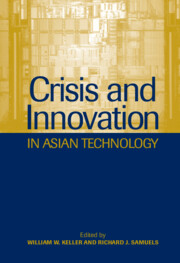Book contents
- Frontmatter
- Contents
- Figures and Tables
- Contributors
- Acknowledgments
- 1 Innovation and the Asian Economies
- 2 Japanese Production Networks in Asia: Extending the Status Quo
- 3 Crisis and Innovation in Japan: A New Future through Technoentrepreneurship?
- 4 Crisis, Reform, and National Innovation in South Korea
- 5 From National Champions to Global Partners: Crisis, Globalization, and the Korean Auto Industry
- 6 Crisis and Adaptation in Taiwan and South Korea: The Political Economy of Semiconductors
- 7 China in Search of a Workable Model: Technology Development in the New Millennium
- 8 Economic Crisis and Technological Trajectories: Hard Disk Drive Production in Southeast Asia
- 9 Continuity and Change in Asian Innovation
- Index
5 - From National Champions to Global Partners: Crisis, Globalization, and the Korean Auto Industry
Published online by Cambridge University Press: 15 December 2009
- Frontmatter
- Contents
- Figures and Tables
- Contributors
- Acknowledgments
- 1 Innovation and the Asian Economies
- 2 Japanese Production Networks in Asia: Extending the Status Quo
- 3 Crisis and Innovation in Japan: A New Future through Technoentrepreneurship?
- 4 Crisis, Reform, and National Innovation in South Korea
- 5 From National Champions to Global Partners: Crisis, Globalization, and the Korean Auto Industry
- 6 Crisis and Adaptation in Taiwan and South Korea: The Political Economy of Semiconductors
- 7 China in Search of a Workable Model: Technology Development in the New Millennium
- 8 Economic Crisis and Technological Trajectories: Hard Disk Drive Production in Southeast Asia
- 9 Continuity and Change in Asian Innovation
- Index
Summary
The Asian Crisis and Korean Economic Nationalism
Of the five Asian economies most severely affected by the financial crises of 1997–98, the Republic of Korea has undergone the most fundamental institutional transformation. For some observers, the Korean response to the crises was all the more surprising because its long-term economic record had been far superior to that of the other crisis economies — Indonesia, Malaysia, the Philippines, and Thailand. Compared with the other four countries, Korea had sustained a higher rate of economic growth (an average of close to 8 percent) for a longer period (more than three decades).
Korean growth, unlike that of the Southeast Asian economies, had been based primarily on the nurturing of domestically owned and controlled companies. The Korean developmental trajectory emulated the technonationalist strategy of Japan. A measure of the success of this strategy was that Korean corporations became household names in the West in consumer electronics, automobiles, and domestic appliances. A Korean company, Daewoo, was the only company not based in Europe, Japan, or the United States that ranked in the mid-1990s in the top fifty of the world's multinationals. Korean firms had logged an impressive number of patents in industrialized economies (see Chapter 4 in this volume).
- Type
- Chapter
- Information
- Crisis and Innovation in Asian Technology , pp. 108 - 136Publisher: Cambridge University PressPrint publication year: 2003
- 26
- Cited by



